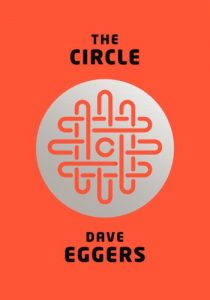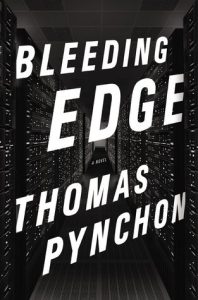Thomas Pynchon
Review by Dan Geddes
5 January 2010
See also:
Inherent Vice (2014) (movie)
The Crying of Lot 49,
Gravity’s Rainbow,
Vineland,
Bleeding Edge and
Dys, an imaginary Pynchon novel
Inherent Vice is a pleasant surprise. After Against the Day’s publication in 2006, expectations for a new Pynchon novel were for the long term.
Inherent Vice is indeed “Pynchon-light”, and as such it has more appeal to non-Pynchon fans than his other works. It is also “low Pynchon,” meaning that it features lots of drugs and sex and oddball characters. It most closely resembles Vineland, which was also received as light Pynchon, and by many critics as inferior to his first three books.
Inherent Vice is a LA Private Investigator story, critics citing Raymond Chandler’s novels, Robert Altman’s movie The Long Goodbye, and the Coen brothers’The Big Lebowski as antecedents.
Pynchon’s PI is Doc Sportello, a surprisingly resourceful hippie, whose ex-girlfriend, Shasta Fey Hepworth, visits him just before her millionaire boyfriend, Michael Wolfmann, disappears. This is the entry point for several overlapping plot strands, as Doc visits an assortment of odd characters, and a few untimely deaths and disappearances take place along the way.
While Shasta Fey is the damsel in distress, Doc’s real bête noire is LAPD Detective “Bigfoot” Bjornsen, who shoots off hilarious, acerbic barbs about Doc’s hippie lifestyle and dope addiction.
Inherent Vice is perhaps Pynchon’s most mainstream novel, in terms of both plot development and characterization. The LA PI story serves as functional vehicle for showcasing overlapping mysteries that are not fully resolved, as well as encountering a host of eccentric characters. So the LA PI tale is in some ways an ideal format for Pynchon’s strengths, given his goals. (Just as the thin spy novel trappings of Gravity’s Rainbow were a proper format). Even most of the minor characters here are distinct enough, as they each play a role in one of the mysteries. The PI format also keeps the story more or less on track, so that the asides, digressions and flashbacks are brief. The characters’ distinctiveness comes mainly from their own agendas in the story; everyone is angling for something.
But the usual criticisms about Pynchon’s style of characterization can also be made about Inherent Vice. The characters speak too much like the narrator, especially by cleverly cataloging things in their dialogue. (They usually have three witty, detailed examples to illustrate their point.) Also, some readers will be distracted by the usual Pynchon-esque character names: Adrian Prussia, Jason Velveeta, Puck Beaverton, Shasta Fey Hepworth (I actually like this name), etc.
Although many of the characters share the narrator’s clever cataloging ability, the dialogue is strong, often hilarious, appropriate for the period, useful for developing the storylines and more or less ready for screenplay adaptation. As Shasta says, she can’t resist delivering those zingers. And Pynchon can’t resist writing them. Doc and Bigfoot Bjornsen’s playful banter should survive into the movie version (assuming one is made) more or less intact. Doc and Bigfoot’s repartee recalls the equally hilarious back-and-forth of Zoyd and Hector in Vineland, where the law man also truculently disparaged the protagonist’s hippie lifestyle, even while trying to recruit him into the Federal snitch program. Bigfoot’s apparent harassment of Doc is courted by Bigfoot’s actual respect for Doc’s sleuthing skills and even his marksmanship. Bigfoot is actually using Doc to help uncover old mysteries that he can’t be seen to be working on himself.
Inherent Vice still more closely resembles other Pynchon novels than it does the traditional PI story. The mysteries themselves can get lost in all the overlapping plot strands and new characters. The most enjoyable element remains the nostalgic re-creation of LA in 1970—the manner of speaking, the drug-use, the carefree ways, the traffic patterns. But as always with Pynchon we read on as much (or more) for the hilarious asides (what one reviewer of Against the Day termed “Pynchonian wallpaper”) as for the story itself. The drug humor will not be to everyone’s taste, but those who found The Big Lebowski funny will feel right at home.
Doc Sportello is probably one of Pynchon’s finest characterizations, and perhaps one of his most autobiographical ones as well (though this is difficult to substantiate). Beyond the superficial trappings of his hippie dress, his diminutive height, his smoking Kools and joints, what stands out about Doc is his easy-going, non-judgmental attitude toward everyone who comes his way. And Doc has occasion to associate with the high and the low, everyone from rich people like Sloane Wolfmann and Crocker Fenway to ne’er-do-wells like Denis, downstairs Eddy, Clancy Charlock, Coy and Hope Harlingen, and so many others.
Doc himself is a lowlife in the eyes of many, but his “groovy” tolerant attitude is genuine. Doc is an authentic character, and is intriguing, because despite his credulity toward weird theories (hippie metaphysics, “hippiphanies”) he is also suitably cynical toward government, business, the LAPD, and many of the eclectic characters he encounters as a PI. His cynicism is the source of much of his mordant humor, directed especially at Bigfoot Bjornsen. Doc provides a sympathetic point of view, and it is easy to view the world through his eyes. He defies the hippie stereotype with his resourcefulness: his ability to conduct himself appropriately (even while under the influence), to don different disguises, to fire a gun, to drive evasively, and even to escape from handcuffs. Doc may not be the most multi-faceted of characters, but for Pynchon this is a sustained portrait, one that is not weakened by the fragmentary characterization or meta-fictional techniques of many of his other works.
Other than the outlandish character names and their tendency to speak too much like narrator the writes, the characterizations are mainly straightforward in Inherent Vice. Some readers may object to the depiction of women, as many are described in terms of their sexual attractiveness. But this is how Doc—a sexually active male under 30, a product of the swinging Sixties—sees them (though not exclusively). Thus, at least three women are described as “presentable.” But even the not necessarily presentable women, such as Doc’s Aunt Reet (seen slathering on makeup for a date), are given funny lines. And though Doc does have sex on the brain, this is credible, and appropriate. Inherent Vice is very much a drugs, sex and rock-and-roll kind of book.
Doc’s drug-use is not limited to marijuana. During the story, he drops acid on the advice of Vehi, Sortilège’s mentor, who uses it constantly as a source of inspiration. Not that Doc needed encouragement; he refers to his previous LSD experiences (and even his agency is named LSD Investigations). Doc does a line of coke with Dr. Blatnoyd “just to be sociable.” He is even tricked into smoking PCP by the villain Puck Beaverton, who uses it as a way to knock Doc out, so that they can take his gun away before killing him. Pynchon makes his usual joke about speed freaks becoming obsessed with painstaking, time-consuming activities: detailing the thousands of bloodshot vessels in the large eyeball on his private detective sign, or creating the unusual plastic shrubbery inside at a diner. The drug use in Inherent Vice is about a certain feeling of freedom that the characters experience from carefree dope-smoking—strangers sharing joints with each other casually, not really worried about the law.
But that is all about to change. The trial of Charles Manson is going on, and LA is watching it with a fascination not unlike the much later O.J. Simpson trial. The Manson family murders ended the image of the harmless, care-free hippie, and thereafter the straight world would always have a certain fear of hippies, and hippies would also fear each other more.
Mutual distrust is also exacerbated by the machinations of the COINTELPRO movement, the federal government’s program of infiltrating progressive movements and the counterculture. Coy Harlingen, the former saxophone player for The Boards (a Beach Boys-like band), joins the federal snitch program as a way to get a new start in life. Doc even sees Coy on television, heckling President Nixon at a political rally in LA. It is clear that he is planted there to discredit hippies by expressing extremist views. Coy is also hanging around with The Boards again, probably spying on them. Perhaps because Coy was befriended by Shasta, Doc tries to help Coy return to his wife and daughter.
Pynchon also portrayed COINTELPRO informants such as Frenesi Gates in Vineland, who was turned from a being a “radical” documentary filmmaker into a federal informant, and even marries another informant. Even though Pynchon is clearly on the “side” of the counterculture, he portrays even these “traitors” to their subculture sympathetically. Pynchon is rarely judgmental toward any of his characters; he shows us the human side even of his villains.
Bigfoot tries to persuade Doc to become a police informant. Doc likens Bigfoot’s offer of a monthly stipend to become an informant to Satan’s offer of the world to Jesus. Clearly many found the offer tempting. Bigfoot even offers Doc payment in a “more inhalable form”—appealing directly to his appetites. But Doc remains strong and refuses the offer.
Clearly the attitude of law enforcement toward marijuana is still fairly relaxed at this time. When Bigfoot orders the forensics unit to scan Doc’s car after the murder of Glen Charlock they find “enough marijuana debris to keep a family of four stoned for a year,” and yet Bigfoot does not bust him (granted that the still-existing constitutional protections against illegal search and seizure in those days still protected him.) Yet there is clearly still a much more tolerant attitude toward marijuana use than we see in Vineland (set mostly in the year 1984), where law enforcement is conducting a veritable war on the drug.
There are many other conflicts in Inherent Vice, but as a novelist Pynchon remains more of a chronicler than a story-teller. In Inherent Vice he is covering a time clearly dear to him, and as such he fills in a gap between the mid-1960s, the period of The Crying of Lot 49, and the mid-1980s period of Vineland (which also utilized many flashbacks the late 1960s and the 1970s. Maybe Pynchon is not a great story-teller (and most of his endings feel unfinished), but he is a great chronicler. Future readers will read Inherent Vice for the 1960s nostalgia, the sharp humor, the insights and understanding, rather than to find out who really kidnapped Mickey Wolfmann.
The nostalgia extends even to American television of the 1960s. Doc’s lawyer, Sauncho, is a fellow stoner and TV junkie, who offers pothead interpretations of Gilligan’s Island, Charlie the Tuna, and The Wizard of Oz (seen on a color TV, which blows Sauncho’s mind). We even see early users of the ARPANET, the forerunner of the internet, displaying early forms of internet addiction. Doc speculates that like things addictive, the government will eventually prohibit the ARPANET.
It’s hard to argue that Inherent Vice is a stronger work of literature than any of Pynchon’s other novels, with the possible exception of Vineland. But it is the most accessible of all his novels, more than the very short Crying of Lot 49 or even Vineland. Pynchon remains a difficult writer. Even with Inherent Vice, it is hard to imagine him finding many new readers; he is just serving up a funny, insightful, nostalgic dish to his established body of readers (sometimes derisively termed a “cult” by his detractors). In most of his novels, the reader cannot really skip the exposition to get back to the action, because the exposition often is the action. We read Pynchon not to see what will happen next, but to see what he will write next. For some this will be mere “Pynchonian wallpaper,” but seeing the insights of the author’s mind is just what many of his readers are looking for.
Probably because of the humor more than anything else, I found myself re-reading Inherent Vice several times. Meanwhile, I still have not been able to finish Against the Day, and it took me several false starts before finally breaking through and getting into Gravity’s Rainbow (which I’ve also re-read several times since). I hope that Inherent Vice is the novel that wins over at least some Pynchon skeptics, so that they see what a fun ride his books can be, even if most of the rest of them require determination to read, as well as awareness that you are reading a clever book more than a compelling story.
At the very least Inherent Vice is obviously filmable, and perhaps Pynchon may finally reach a wider audience via the first film adaptation of his work.
See also:
Inherent Vice (2014) (movie)
The Crying of Lot 49,
Gravity’s Rainbow,
Vineland,
Bleeding Edge and
Dys, an imaginary Pynchon novel









Be First to Comment